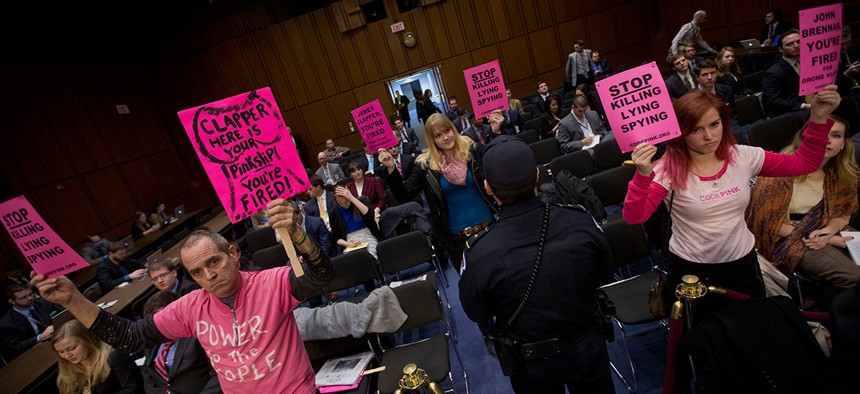
A Capitol Police officer monitors members of Code Pink as they hold up signs in the Capitol in 2014. Pablo Martinez Monsivais/AP
Inside the Sometimes Crazy World of Capitol Hill Protesters
There are not always outbursts, and they (usually) get along just fine with the Capitol Police.
Margaret Flowers listened for nearly 30 seconds. Then she'd had enough.
It was a morning in late January, and she was sitting in the crowd for the Senate Finance Committee's hearing on President Obama's trade policy—including the Trans-Pacific Partnership. Flowers listened as U.S. Trade Representative Michael Froman began his opening remarks to the panel, but she would not let him finish uninterrupted. Flowers, co-director of PopularResistance.org, stood up, held her handmade "Trading away our future" sign up high and began to shout: "Ambassador Froman, you're not telling the American people the truth! We know the Trans-Pacific Partnership has been negotiated in secret for five years!"
Police leapt to their feet. Flowers was escorted out of the hearing room and arrested. Before Froman could utter another word, two more protesters picked up where Flowers had left off, walking toward the witness stand with a "TPP Fast-Track Job-Killing Act" sign in hand. They, too, were led away, eliciting a scolding from Sen. Orrin Hatch: "Now look, the committee will be in order," the Finance Committee chairman said. "Comments from the audience are inappropriate, they're out of order, and if there's any further disruptions, the committee will recess until the police can restore order."
To an outsider, and on the C-SPAN cameras, it appeared chaotic: a rapid switch from a pre-programmed hearing to shouting, confrontation, and an arrest. But to Congress's repeat protesters—and to the officers who continually arrest them—such confrontations rarely contain surprises, and the conflicts come with surprisingly little rancor.
"I think, in general, when we go into these types of actions, we always know that we're risking arrest," Flowers said. "It's never the intention to get arrested, but it's always a risk."
Outbursts in committee hearings are common, and though they don't always lead to arrest, many know the potential consequences of such disruptions. It's typically worth it to the protester, who aims to throw a different voice in the mix of what can be fairly scripted politics and hope the video feed, along with their message, gets out to the general public. But to law enforcement, it's a balancing act between protecting the First Amendment's right to free speech while ensuring the hearing quickly steers back on course.
Generally, the interruption isn't a total surprise to the Capitol Police, the chairperson, the committee staff, or the chamber's sergeant at arms. They work in tandem to identify hearings with contentious topics and witness lists. They can increase police presence in a hearing and chat with the committee chair and ranking member beforehand to craft a potential protest game plan. All this is an attempt to achieve the ultimate goal: a safe space for the witnesses, attendees, and politicians, but one that is amenable to opposing viewpoints.
"[The goal] is to have an open hearing, and sometimes those are imperfect and not pretty," said Terrance Gainer, who has served as Capitol Police chief and Senate sergeant at arms. "The general tenor that I've seen on Capitol Hill is not to lock people up as long as safety is not compromised. Everybody on the Hill is a little bit tolerant of people with opposing points of view sometimes being loud, sometimes being obnoxious, and sometimes being rude."
Some protesters, such as those from the antiwar advocacy group CodePink, are a frequent sight in Capitol Hill's committee rooms. They're typically easy to spot as they form a line to enter a hearing: The signs and t-shirts are a giveaway to Capitol Police officers, who often chat with CodePink members and protesters before the activists head inside. It's a cordial, friendly relationship, Alli McCracken, CodePink national coordinator, said.
"'What kind of trouble are you getting into today? Is anybody going to get arrested?' That's their standard question after we've asked how their kids are doing," McCracken said.
At least, that's how it usually goes. But sometimes protesters push past a point that lawmakers can tolerate.
That's what happened in a Senate Armed Services Committee in January, when demonstrators ran afoul of Sen. John McCain while protesting an appearance by Henry Kissinger.
As the former secretary of State walked into the hearing room, a group of CodePink protesters walked toward him down the hearing room's center aisle, shouting, "Arrest Henry Kissinger for war crimes!" They gathered near the witness table, where Kissinger had taken a seat. They held signs calling him a war criminal and continued chanting their message. One shook handcuffs near Kissinger's head, as McCain called on the Capitol Police to calm the small crowd. ("Can I ask our Capitol Police to help restore order here? Can someone please find out where the Capitol Police is?" the Armed Services Committee chairman asked).
"I've been a member of this committee for many years," McCain said as the protest died down after less than two minutes of chanting, "and I've never seen anything as disgraceful and outrageous and despicable as the last demonstration." He later called the protesters "low-life scum," comments that quickly went viral.
The incident prompted an acknowledgement from Capitol Police that it mishandled its response. It propelled the Armed Services Committee to get rid of center aisles, opting for uninterrupted rows of seats near the witness table instead. It sparked a meeting between the Senate sergeant at arms, the secretary of the Senate, the committees, and the Capitol Police. And it prompted the new Senate Sergeant at Arms Frank Larkin to reclarify guidelines already in place: "Anyone that is to be removed from a hearing room for inappropriate behavior—whether it presented a safety issue or a security issue—would be arrested," Larkin said at a Senate Appropriations Legislative Branch Subcommittee hearing on funding for his office.
What falls under this category is a "true test of common sense," Larkin told National Journal. It's protesters becoming physical: Swinging signs in a way intended to hit others or acting in a seemingly threatening manner.
But standing up and voicing an opinion is a more common occurrence. It's expected. It's part of the open-hearing process. And it can be completely fine. Yet, when protesters refuse to stop chanting, that's what leads to handcuffs.
"They're advised before the hearing that, if they have to be removed from the hearing room, they will be arrested," Larkin told National Journal. "Now if they choose to leave the hearing room, [there's] no issue. Or if they're asked to leave the hearing room, and they leave, there's no issue. But if they do not cease their behavior, if they do not comply as instructed, then they will be removed from the hearing room and arrested."
(House Sergeant at Arms Paul Irving declined to comment.)
In that now-infamous Armed Services Committee hearing, CodePink contends it would never touch a witness. The grassroots organization working to end U.S. wars and militarism is a peaceful group, McCracken said.
Sometimes, CodePink attends hearings just to listen; other times, they hold signs displaying their message. But when members feel there isn't a voice for peace on the panel, that's when they speak out, an occurrence that happens about every few weeks, McCracken said. If the incident is caught on C-SPAN, then their antiwar message has the capability to spread past Capitol Hill's walls and to the general public.
Disrupting a congressional hearing is an art form other activists say CodePink has mastered.
"CodePink is kind of an expert at zapping a congressional proceeding. And for years and years now, any time there's something pertinent to the War on Terror that's public, they're there, and you can see their signature in the video feed," said Jeremy Varon, of Witness Against Torture, a group advocating for the closure of Guantanamo Bay. "The danger is it can start to feel like an empty ritual, and they're just part of the furniture of whatever chamber they're in. … That's always the danger, but I'm really glad that they're there, and occasionally, they do it in such a demonstrative way [that it gets attention]."
The Capitol Police protect the right to protest—to a point. "We balance providing security with maintaining a safe and open campus that is accessible to the general public," Lt. Kimberly Schneider, a Capitol Police spokeswoman, wrote in an email. "Our officers regularly receive legal updates, department-issued bulletins, and in-service and roll-call training. The USCP routinely communicates with the congressional community to facilitate the ability of Congress to fulfill its constitutional responsibilities in a safe and open environment."
And sometimes the protesters surprise themselves.
In early February, Helen Schietinger sat in a Senate Armed Services Committee hearing on the U.S. detention facility in Guantanamo Bay. She wore a sign saying, "I died waiting for justice—Adnan Latif," a reference to a Yemeni prisoner who died in Guantanamo. Schietinger is part of the group Witness Against Torture, but she did not plan to interrupt the hearing. Doing so would mean police leading her from the room, likely handcuffing her, and eventually arresting her. But as Schietinger listened, her frustration rose. Sen. Lindsey Graham said the prisoners are locked up for a reason. Sen. Tom Cotton said detainees could rot in hell and in Guantanamo.
So Schietinger stood up and raised her voice.
NEXT STORY: Play of the Day: Me Llamo Jeb






